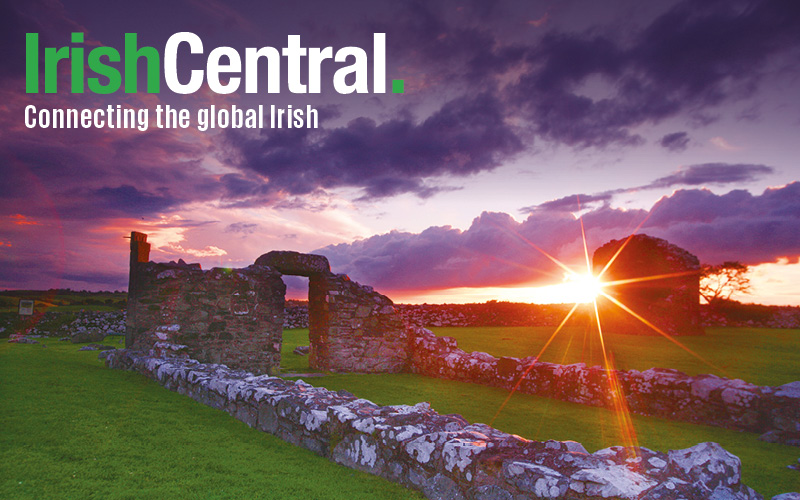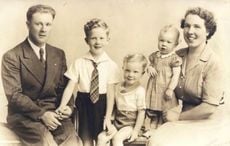The "peace line" between Falls Road and Shankill Road doesn't just start in 1969 but it's modern embodiment 50 years on, remains
A 'peace line' has been in place in Belfast since September 1969, between the Falls Road (predominantly Catholic) and Shankill Road (mainly Protestant). The story of the peace line doesn’t just start in 1969, though, as its route traces a much older course, that of the River Farset, from which Belfast takes its name.
The days following Tuesday, Sept 9, 1969, saw the start of a process of converting the barriers hastily thrown up during the violence of mid-August 1969 into a more formal structure. Locals had thrown up barricades at the end of various Belfast streets that summer. These were made from broken paving stones, burned vehicles and anything that had come to hand.
On Aug 15, the British Army took up positions along the Falls Road having been advised by the Unionist government that the Irish Republican Army (IRA) had begun an insurrection. Within hours, the British redeployed along the interface between the Falls Road and Shankill Road to prevent further attacks from the Shankill Road into the Falls Road. Along a route from the Springfield Road to Divis Street, it formed what Sir Edward Peck of the British Foreign and Commonwealth Office described to an Irish diplomat as a "human barricade". This was the first incarnation of the 1969 peace line.
The British Army had been on duty in the north of Ireland since April 1969, when an Ulster Volunteer Force bombing campaign had attempted to prevent any moves towards dealing with the issues raised by civil rights groups. A small British Army engineering detachment that had been deployed in April had wood and barbed-wire barriers (known as ‘knife rests’), rolls of barbed-wire and iron pickets to create wire entanglements with the barbed-wire.

Britisih soldiers with knife rests in Belfast
Despite public attempts to have the August barricades taken down and a return to some semblance of normality, the Unionist government was acutely aware of the likely impact of an imminent report (the Cameron Report) that was going to be published in mid-September 1969 that would be highly critical of the Unionist government and its military force, the Royal Ulster Constabulary. So on Sept 9 a decision was made to create a formal barrier along a line dividing the Falls Road and Shankill Road districts to prevent a repetition of the events of August 1969.
Early September 1969 was to be a critical month in the evolution of the conflict over the next few years. The IRA in Belfast, practically unarmed and poorly organized in early August, had, by the start of September, suddenly found itself in direct discussions with British Army chiefs over the removal of barricades and jointly providing security to the streets off the Falls Road. By the end of the month, the Belfast IRA had broken with the IRA leadership in Dublin over the IRA strategy and began preparing to escalate a military campaign in the north.
On Sept 9, the Unionist Prime Minister James Chichester Clarke made a televised broadcast saying:
“We have now decided that the army will erect and man a firm peace line to be sited between the Divis Street area and Shankill Road on a line determined by a representative body from the city hall. In conjunction with this action, barricades will be removed in all areas of Belfast, both Protestant and Catholic.”
‘Peace line’ now entered the security lexicon, although ‘peace wall’ was occasionally, if more rarely, used. Ironically, prior to 1969, the phrase ‘peace line’ was generally just associated with the demarcation line from the end of the Korean War which is also still in place.
You can see the early peace line being constructed and see how it looks in the video below.
The initial reaction from representatives of the Catholic residents was very negative. Peace lines were not a new feature of the security landscape in Belfast. During the violent pogroms of 1920-1922, a number of peace lines were constructed, completely sealing off the end of some streets in Ballymaccarret in the east of the city. Again, in 1935, sectarian violence saw complete barriers erected across the ends of a number of streets in Sailortown (in the docks area). On both occasions, the closure of streets had curtailed social and business life. In 1935, Catholic residents of Sailortown had opposed the closure of streets realizing that it promoted division rather than attempted to resolve it. On those occasions, public pressure saw the ‘peace lines’ removed within one to two years.

Peace line, 1935, Sailortown (Irish Press, 7 July 1935)
In 1969, the intended temporary and military nature of the ‘peace lines’ was reflected in the initial construction. British Army engineers drilled holes in the road surface and then hammered iron pickets into place. Barbed wire strung between these iron pickets created what the British Army’s Manual of Field Works calls a ‘low wire entanglement’. Construction by British Army Engineers was escorted by the 2nd Grenadier Guards and began at either end of the peace line. Work was to progress towards a center point on the route agreed by a working group of all the Belfast city councilors for the ward. Construction at the eastern end was immediately obstructed by a failure to agree the route on Dover Street and it was the last section to be completed. According to The Irish Press (11 Sept. 1969), on the first-day work had begun with rival crowds singing “Go home you bums, Go home you bums…” (to the tune of ‘Auld Lang Syne’) to the soldiers involved.
Within a couple of weeks, the limitations of the low wire entanglements and the lack of appropriate crowd-control training for the British soldiers were badly exposed. The wire entanglements did not provide a visual barrier, unlike those erected in 1922 and 1935. Hostile crowds could throw (and shot) at targets they could see and, due to the inaction of the British soldiers, could literally push the wire entanglements aside and attack the other side. This was particularly evident in Coates Street on the Sept 25.
By Sept 29, British Army engineers were replacing the ‘low wire entanglements’ with another military option – ‘concertina-type’ barriers made of ten to fifteen feet high sheets of corrugated iron erected on fence-posts. They now resembled the form familiar in most early photographs of the conflict in Belfast.
The Unionist Minister of Home Affairs, Robert Porter, speaking in Stormont on Oct 7, said that the barriers were intended to be temporary. But fifty years later, having been strengthened from corrugated iron to ugly concrete walls and expanses of urban wasteland, the ‘peace lines’ are still in place.
You can watch Sean Murray's recently released short film about the peace line, 'The Wall' here:
While everyone laments the failure to have the ‘peace lines’ removed, few people recognize how they mirror a long-standing physical division of the city. The peace line between the Falls and Shankill actually follows the course of the River Farset.
Belfast is an anglicized form of ‘Béal Féirste’ which, in Irish, means the ‘mouth of the Farset’. Early settlement in the Belfast area may have centered on the old church (‘Sean Cill’ in Irish, anglicized as Shankill) from which the Shankill Road takes its name. The church lies alongside where the road crosses the River Farset (arguably Belfast could even be an anglicization of ‘Baile Féirste’, the town on the Farset).
Businesses were attracted to the river, utilizing its water for power and industrial processes in the factories, mills, and foundries that established in an industrial district along the banks of the Farset itself. Unscrupulous factory and mill owners could play on religious tensions and fears to deflect from poor work and housing conditions. The communities that then grew along both the Shankill and Falls Road, on either side of the River Farset, tended to have greater proportions of Protestants (Shankill) and Catholics (Falls) as intermittent violence throughout the 19th century often lead to sporadic increases in segregation (and thus perpetuated the tensions).
The final expression of this appears to be the tracing of the ‘peace line’ in September 1969 along a route that mirrors that of the Farset itself. The river is now buried in culverts all through the district. But maybe any future without the ‘peace line’ really lies in rediscovering the river underneath that actually gave Belfast its name.
You can read more about the backdrop to the construction of the peace line in John O'Neill's 'Belfast Battalion: a history of the Belfast IRA, 1922-1969'.
You can see a more detailed map of the peace line and course of the River Farset below.

Map showing details of the route of the 1969 peace line and the River Farset
This article was submitted to the IrishCentral contributors network by a member of the global Irish community. To become an IrishCentral contributor click here.




Comments